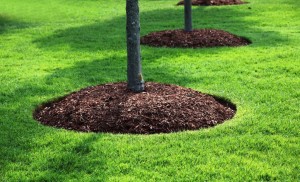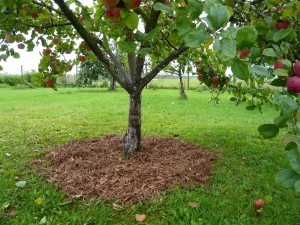Decorative mulch
Mulch – one of the agricultural engineering measures to protect plants and soil from the adverse impact of temperature and drying as well as to enrich the soil and prevent weeds breed. Decorative mulch – protective, nourishing, decorative ground cover, made of shredded, sieved and painted coniferous and deciduous wood (0-30 mm), pH-neutral. Colors – brown, brick red, yellow. This is a perfect measure for garden and decorative plants fostering – improving many of the factors that determine the conditions of the plant growing, and at the same, making the environment more embellished, giving the impression of completeness.
Soil temperature – in winter time, mulch protects the roots of plants from sudden temperature drop and temperature fluctuation, while in the spring – from frosting and in summer time – on the contrary, it helps to maintain the lower, most optimal soil temperature for the plants. Mulch reduces the temperature of soil surface, thus speeding up the decomposition of nutrients. Also it mitigates the variations of the daily temperature, which is very positive to the quality of the garden plants and fruits as well as the beauty of decorative plants. Mulch stops the late sprouting and slows the leaf falling in autumn. It is very important for less frost-resistant garden and decorative plants to withstand the cold winters as the plants have more time to acclimatize.
Soil humidity. Mulch preserves soil moisture, retaining 60 proc. of water, which usually evaporates. Also water evaporation from plants is reduced. Moisture reserve is accumulated during the rain or watering and the soil stays moist for a longer time.
Soil aeration properties. Mulch retains soil microflora, allows the plant roots to breathe more easily by keeping the soil looser as well as more permeable to air and prevents the formation of soil crust.
Protection from weeds. Mulch is impermeable to light and therefore creates unfavorable conditions for weed sprouting and growth.
Protection against soil erosion. Mulch creating a protective layer, reduces the soil, water and wind erosion (destruction, washing) and does not allow the rain for soil particles washing as well as wind for their removal.
Nutrients absorbing. Organic mulch slowly decomposing improves the structure of soil. It is like repetition of natural soil formation process and plant used organic matter returning to the ground. Mulching is like composting at the plant roots. Plants better absorb the nutrients from the soil covered with mulch.
Plants diseases spread. Increases the resistance to diseases and does not provide the favorable conditions for pests to reproduce. At the same time, the better environment for useful soil bacteria multiply and act are created.
Use. After setting the mulching zone, first all weeds must be eradicated from the plants area and beds also the soil loosened and complex fertilizers added (rate – 30 g/m2) – the best option – long-acting ones, thus no additional fertilization shall be needed. The newly planted garden and decorative plants shall be mulched added to the level of pit or a little wider, while older growing plants – much wider. Mulching a separate tree or bush, the circle of half of its crown needs to be drawn around the stem. Coniferous surrounding mulch can be its crown size or even larger, depending on the future growth. Using the decorative mulch is recommended to remove 5 cm of soil surface around this zone and reinforce the edges with the lawn-curbs. Area to be mulched for plant groups usually shall cover the entire surface area and shall be equal to the plant crown projection on the surface. Preparing the soil for coniferous mulching, the surface roots must be especially protected. Then the soil surface must be covered with 5 cm thick mulch layer, but not thicker. Mulch needed – 50 ltr./ 1 m2 applying the 5 cm thick layer. Mulching at the plant stems, 3-5 cm gap must be left, in order the very sensitive bark at the neck would not swelter. If the mulch layer is too thick, the plants can be harmed also the moist and nutrients will penetrate harder, and if too thin – the desired result will not be reached.
Time. Mulch shall be applied on dry, sunny day. Prior to the mulch covering, it is recommended once additionally fertilize the plants, such as, rhododendrons, blueberries with nitrogen fertilizers. Plants can be mulched all year round. The optimal mulching time depends on the desired targets. If mulch shall be used to protect from the winter cold and spring frost, mulch is best to be applied in the late autumn. Then it is recommended to wait for the first cold that the soil surface would start to frost. Applying mulch it is necessary to protect the plants from the mice and other rodents, as they feel very good in the loose material and can make a lot of harm to the plant roots. In spring time, mulch shall be applied when the ground is thawed and no frost is left, but the moisture has not evaporated yet. Optimal time – mid-April. It is recommended also to mulch in later years, as while loosening, the mulch mixes with the surface layer of soil, thus activating the microbial activity and organic matter rots much faster, providing more nutrients to the plants. After two-three years, mulch layer should be supplemented by 2-3 cm. Mulch layer can be supplemented when the soil and the current layer is fully warmed, at any time during the growing season, but it is important to take it easy and follow the norms.









